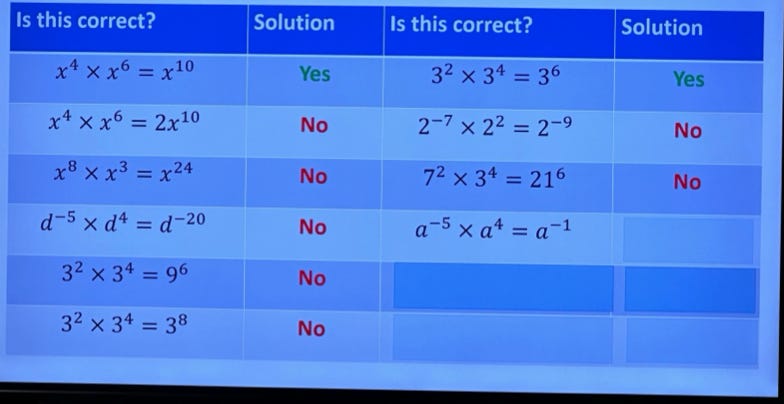#61 Sometimes mini-whiteboards are not the best way to collect whole-class data
An example from a recent school visit
Hello, and welcome to the Tips for Teachers newsletter.
I have 7 free websites
I write 2 free weekly newsletters
I host 2 free podcasts
I share over 200 free CPD videos
If you find my work useful, please consider becoming a Patreon
💡 A tip to try in class this week 💡
Regular readers will know that I love a mini-whiteboard. I know of no more efficient way to ascertain the effort and understanding of all students than to ask them to write their answer to a question on a mini-whiteboard and show me on cue.
But mini-whiteboards are not the best tool for some questions. I am not talking about questions requiring long, verbal responses - Cold Call or Turn and Talk are best for those. No, I am talking about questions with a small, finite number of answers.
Example 1
Consider this multiple-choice diagnostic question:
When students write their answers on mini-whiteboards, it looks like this:
Notice how difficult it is to identify students’ choices of answers, especially those at the back. My preferred way of collecting data for multiple-choice diagnosis questions is to use coloured ABCD cards or head down first on head.
Example 2
Consider this question:
The teacher asked students to write their answers on their mini-whiteboards and then hold them up so he could check their understanding. The boards looked like this:
With 30 students in the class, there was too much data to identify who was correct and who was not. A better approach would be to ask students to raise their hand if they think A is written in standard form, respond accordingly, and then repeat for B. This reduces the flow of data, giving the teacher the best chance of accurately diagnosing the level of understanding.
Example 3:
Finally, take a look at this exercise:
Again, data was collected on mini-whiteboards:
This was difficult to see, compounded by dirty boards and small writing. A better solution here would be to ask students to put their thumb up if they thought a solution was correct, and thumb down if they thought it was wrong.
Conclusion
In each of the examples above, whiteboards could be used for students to do their working out on, but then another tool could have been used to make the required quick-fire analysis of the data more manageable.
What do you think of this idea?
What would you need to change to make this tip work for you?
When could you try it for the first time?
View more than 200 Tips for Teachers
🏃🏻♂️Before you go, have you… 🏃🏻♂️
… tried last week’s tip about not having the title and date visible during the Do Now?
… read my latest Eedi newsletter about my 5-point CPD charter?
… listened to my latest podcast about atomisation and unstoppable learning?
… read my Tips for Teachers book?
… considered booking some CPD, coaching or maths department support?










Craig, I was told about this method today by a primary school teacher. The fact is, whiteboards glare and dazzle for some people. So this will compromise the results. See my book based on PhD research, personal and professional experiences. " Light Sensitive Learners. Unveiling Policy Inaction, Marginalisation, Discrimination". ISBN: 9781662944666
eISBN: 9781662944673
Thanks for your blog and photos. Helped me understand what that primary school teacher was talking about.